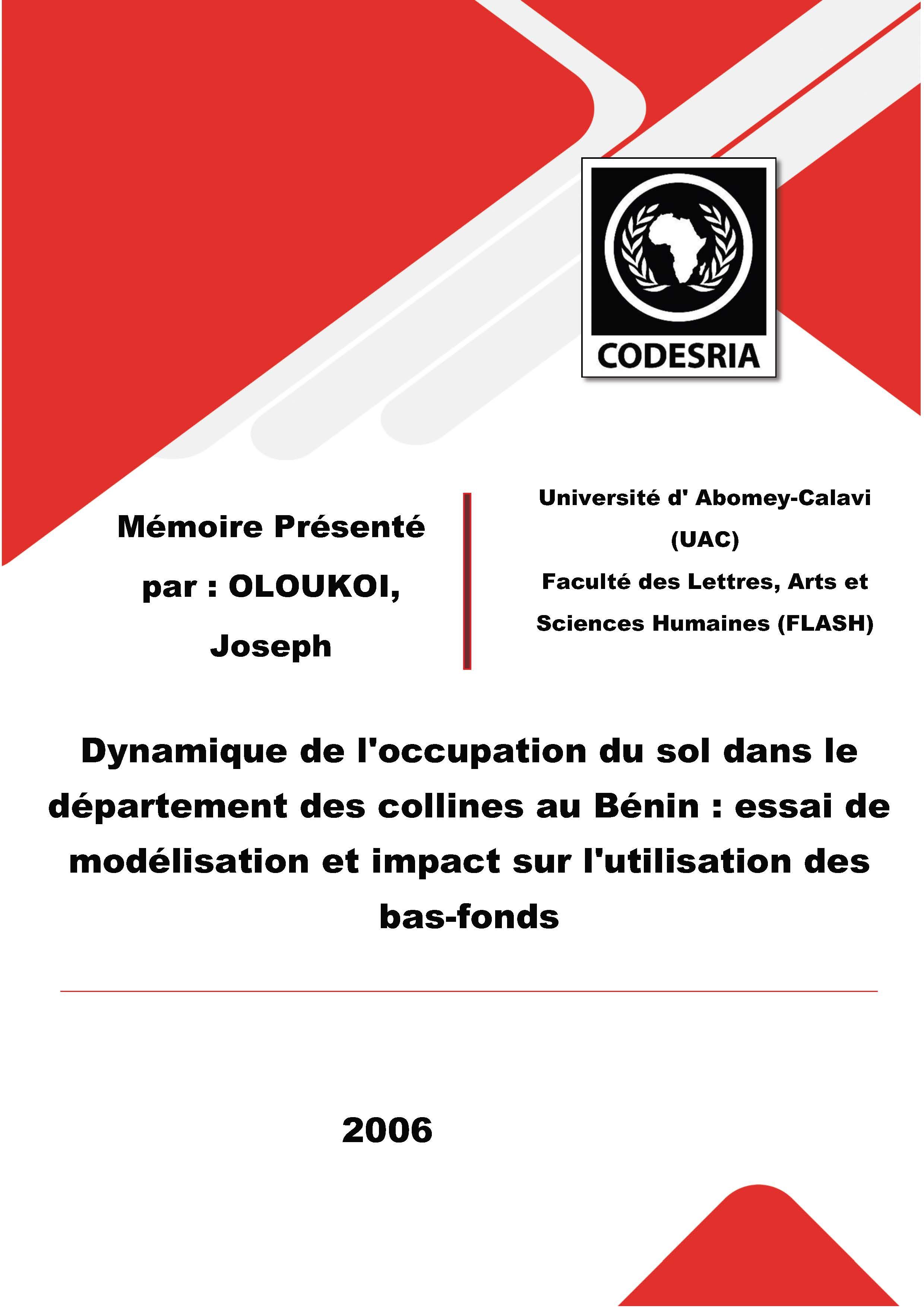Dynamique de l'occupation du sol dans le département des collines au Bénin : essai de modélisation et impact sur l'utilisation des bas-fonds
Keywords:
Utilisation du sol, effets sur l'environnement, bas-fonds, occupation des sols, modélisation, BéninSynopsis
The current research deals with the land use and land cover changes in the department of Collines in
Benin and its impact on inland valleys exploitation. The main objective of this exercise is to assess the
spatio-temporal dynamics that affects this department, dynamics caused by the various practices
observed in matter ofresources exploitation, and to analyze the corollaries especially as far as the inland
valleys use is concemed.
On the basis of Remote Sensing tools and Geographical Information System (GIS), the changes of the
land use and land cover between 1978 and 1998, revealed that only 22.3 % of all the studied area is
stable, 59.4 % is in regression and 18.3 % extends. Spaces in regression concem the woody savannah
and the gallery forest.
The modelling of land use and land cover change, usjng Cellular Automata in the base of Markov
processes, leads to the setting up of a transition matrix that reveals that most of the land use and land
cover units has changed extensively toward crops and fallows in 1998. Factors of conversion assessed
for most of the land use land cover classes (agglomerations and saxocolon savannah not include), are
higher than 60 %. Simulations made on the basis of probabilities for an unit i to be converted to another
unit j reveals that the probability for forested area to be transformed into crops and fallows in the region
of Dassa and its environment, is high and varies from 30 to 53 %. Projections made for 2010 and 2020
horizon, reveals that in the future, while agglomerations, crops and fallows will spread, the forested
areas will decrease strongly.
The importance attached to the agriculture in the economic system and the rural migrations observed in
the study area explain the extension of the cultivated spaces. In this optic, lands will be scarce and
people will concentrate themselves on humid land like inland valleys, considered once as marginal
areas. The way the pressure on these new area is going, their future is not well insured as shown by the
examples of Kpole, Kotobo and Kpatiko inland valleys. The pressure occurred on these inland valleys is
expressed by the strong values of the land utilization rate (89.4 %). An immediate consequénce ofthese
signs is the degradation of animal and vegetal resources and in the future, the rupture of the ecological
stability of the area
Downloads
References
Adjinda, A.S. et Hounton, K.N. (1997) Contribution à l'étude de la dynamique de l'environnement dans une zone d'accueil : cas des sous-préfectures de Savè, Ouèssè et Tchaourou. Mémoire d'ingénieur des Travaux, CPU/UNB, Abomey-Calavi, 84 p.
Afouda F. (1990): L'eau et les cultures dans le Bénin central et septentrional: étude de la variabilité des bilans de l'eau dans leurs relations avec le milieu rural de la savane africaine. Thèse de doctorat nouveau régime. Paris IV Sorbonne, 428p.
Agbossou, E., Danvi, C., Assigbé, P., Adégbola, P., Mama, V.J. (1999): Diagnostic rapide d'aménagement (DIARPA) dans les bas-fonds de Sowé, Magoumi, Baatè, Lèma, Loulè, Gankpétin et Gomé, Rapport de projet, UNC, CBF, 54 p.
Akoègninou, A. et Akpagana, K. (1997) : Etude cartographique et dynamique de la végétation de l'aire classée de la colline de Savalou (Bénin), In J. Bot. Soc. bot. Fr. 3 : pp 69-81.
Bernier, B. (1992): Introduction à la macroéconomie. Dunod. Paris, 217 p.
Boko, M. (1988): Climat et communautés rurales au Bénin, rythmes climatiques et rythmes de développement. Thèse de doctorat d'Etat. Dijon, Université de Bourgogne. 605p.
Bokonon-Ganta E. B. (1987): Les climats de la région du Golfe du Bénin. (Afrique Occidentale). Thèse de doctorat du 3ème cycle. Paris IV, Sorbonne. 248p + Annexes.
Biaou, F. (1998) : Quelques aspects socio-économiques de la caractérisation semidétaillée des bas-fonds du Zou-nord (Bénin). In Marna, V. J., Houndagba C.J., Agli C., Orekan V. O.A. (eds) (1998) : Connaissances et mises en valeur durable des basfonds au Bénin. Actes du séminaire national de l'UNC Bénin, 7-9 octobre 1998, Bohicon, Bénin, pp 48-61.
Blanchet, F., Ahmadi, N., Simpara, M., Feuillette, B. (1995): Le diagnostic préaménagement: une méthode de caractérisation des bas-fonds à l'usage des opérateurs du développement. ln Jamin J.,Y., Windmeijer P.N. (eds). La caractérisation des agroécosystèmes de bas-fonds : Un outil pour leur mise en valeur durable. Actes du rr Atelier scientifique du Consortium bas-fonds, ADRAO, Bouaké, 8-10 juin 1993, Bouaké, Côte d'Ivoire, IVC/CBF, pp 77-87.
Borgui, C. et Leffi, S. L., (1992) : Aspect actuel de la dynamique de l'environnement dans les versants ouest du cours de l'Ok.para Mémoire de maîtrise de géographie, FLASH, UNB, 95 p.
ENATEL (1995): Carte de végétation du Bénin. Un instrument pour une meilleure gestion des ressources naturelles. Données de base et méthodologie, rapport, 15 p.






